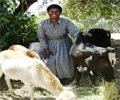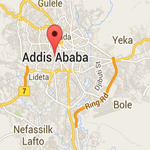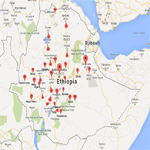Background of RUFIP

The limited outreach of the commercial banking system and NGO supported credit schemes and the uncertainty surrounding the sustainability of the input supply loan programme have galvanized Government of Ethiopia (GOE) to establish a legal and policy framework conducive to the growth of microfinance institutions (MFIs) and rural saving and credit cooperative societies (RUSACCOs).
The country strategy recognizes that one of the major constraints to the sustained increase in agricultural production and productivity islack of access to reliable financial services by poor rural households who account for about 85% of the total population. Rural Financial Intermediation Programme (RUFIP) has been proposed as one means of tackling the problem.
The Rural Financial Intermediation Programme (RUFIP) is national, sector wide investment, which address key institutional and policy issues critical for the development of vibrant and sustainable rural financial system. The rationale and urgent need of the RUFIP is to reduce poverty in the rural areas of the Country.

Rural Financial Intermediation Programme (RUFIP)
Objectives
The programme goal is to alleviate rural poverty through the sustained increase in incomes and assets of poor rural households. This would be attained through increased agricultural production and productivity in addition to off-farm and none farm income generating activities. The programme’s primary objectives is to promote the effective delivery of efficient, demand driven financial services responsive to the needs of the rural poor, including smallholder framers.
Specific objectives of the programme
RUFIP aimed at
- Expanding outreach to about 6.9 million rural households by 30 June 2019 through financial deepening, institutional development, and provision of equity and credit funds concomitant with savings mobilization, sound prudential norms, operational and financial sustainability and good governance.
- Develop a community banking framework through the establishment of grass – roots, people owned and managed rural savings and credit cooperatives (RUSACCOs).
- Promote linkages between rural financial institutions and the banking system.
- Improve regulation and supervision through support to the NBE and the AEMFIs.
- Strengthen the institutional capacity of Federal and Regional cooperative Promotion Bureaux to effectively promote, supervise and regulate RUSACCOs and their unions.
Programme Cost and Financing
The total estimated RUFIP II cost is USD 248 million (ETB 4.23 billion). Pertaining to the overall programme cost financing arrangement, from the total program cost (International Fund for Agriculture Development) IFAD, (Commercial Banks) CB’s, (Development Bank of Ethiopia) DBE, (Government of Ethiopia) GOE and (Micro Finance Institutions) MFIs would contribute 41%, 30.3%, 13.8%, 11.7% , 2.7% , and 0.5% respectively.
Programme Components
RUFIP comprised four components which include:
- Institutional development within the microfinance and cooperative sub-sectors.
- Improved Regulation and supervision of Micro Finance Institutions (MFIs) by strengthening the institutional capacity of National Bank of Ethiopia (NBE), Association of Ethiopian Micro Finance Institutions (AEMFIs)
- Equity and Credit Funds for MFIs and RUSACCOs.
- Programme coordination and management.
Programmme Organizing and Executing Agency
The key agencies responsible for implementation of the programme are:
- Development Bank of Ethiopia (lead implementing Agency)
- National Bank of Ethiopia (NBE)
- Association of Ethiopian Microfinance Institutions (AEMFIs)
- The Domestic Commercial Banks
- The Federal and Regional Cooperative Promotion Bureaus (FCA)
Programme Coordination and Management Unit
A programme coordination and management Unit (PCMU) has established in DBE which is primarily responsible for management of equity and credit funds, institutional development of MFIs in association with AEMFIs and the overall coordination of programme activities. There are also two committees that would involve in policy and decision- making in the programme implementation process. These committees include:
- Progrmme Management Committee (PMC): the main function of this committee shall involve in decision making and guiding of the overall programme implementation process.
- National Rural and Microfinance Policy steering committee (NRMFPC): this committee shall mainly involve in policy issues at national level.
Programme operation current status
RUFIP I have been under implementation for 7 years since 2003/4 to 2009/2010 a total programme cost was USD 88.73 million. As per the interim evaluation of Rural Financial Intermediation Programme I (RUFIP) conducted by IFAD in 2009, RUFIP I was successful in achieving its objectives in the microfinance sub-sector and had a real and sustainable impact on rural poverty. The programme was found to be relevant and timely, and its overall performance was satisfactory.

In view of the overall results obtained from RUFIP I, the interim evaluation made a strong case for the development of a second-phase of RUFIP. As a result the government of Federal Democratic Republic of Ethiopian and IFAD agreed to have the second phase of the programme i.e. RUFIP II.
RUFIP II builds on the success of the Rural Financial Intermediation Programme one to scale up the delivery of financial services from a baseline of about 3.3 million to 6.9 million poor rural households by 30 June 2019, the total estimated RUFIP II cost is USD 248 million (ETB 4.23 billion). The government and financers reached to consensuses for the launching of RUFIP II for the next seven years (2011/12- 2018/19).
The overall development objective of the programme is to provide sustainable access to rural households to a range of financial services through a nationwide network of some 30 MFIs and about 5 500 RUSACCOs (and 100 unions of RUSACCOs) as well as capacitating the programme beneficiaries in the form of capacity building. RUFIP II was launched on July 2012 and started operation for the past one year
















